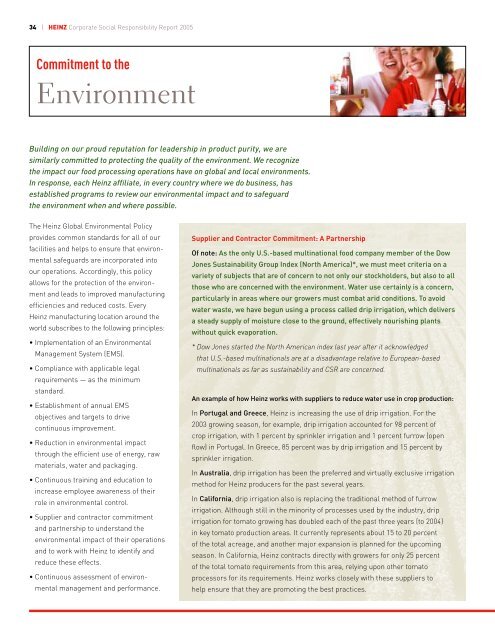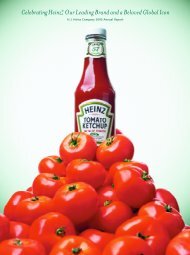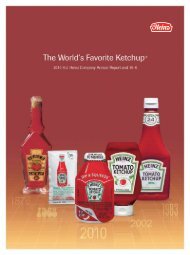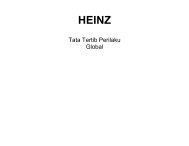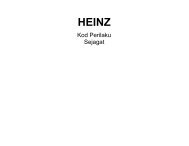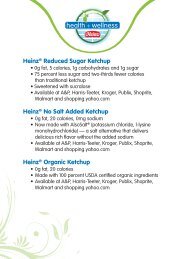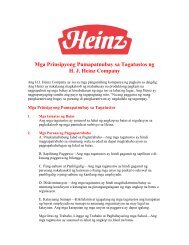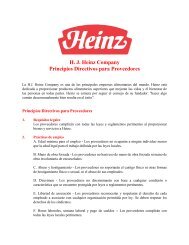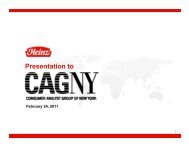GOOD FOOD, EVERY DAYâ„¢ H.J. Heinz Company
GOOD FOOD, EVERY DAYâ„¢ H.J. Heinz Company
GOOD FOOD, EVERY DAYâ„¢ H.J. Heinz Company
You also want an ePaper? Increase the reach of your titles
YUMPU automatically turns print PDFs into web optimized ePapers that Google loves.
34 | HEINZ Corporate Social Responsibility Report 2005<br />
Commitment to the<br />
Environment<br />
Building on our proud reputation for leadership in product purity, we are<br />
similarly committed to protecting the quality of the environment. We recognize<br />
the impact our food processing operations have on global and local environments.<br />
In response, each <strong>Heinz</strong> affiliate, in every country where we do business, has<br />
established programs to review our environmental impact and to safeguard<br />
the environment when and where possible.<br />
The <strong>Heinz</strong> Global Environmental Policy<br />
provides common standards for all of our<br />
facilities and helps to ensure that environmental<br />
safeguards are incorporated into<br />
our operations. Accordingly, this policy<br />
allows for the protection of the environment<br />
and leads to improved manufacturing<br />
efficiencies and reduced costs. Every<br />
<strong>Heinz</strong> manufacturing location around the<br />
world subscribes to the following principles:<br />
• Implementation of an Environmental<br />
Management System (EMS).<br />
• Compliance with applicable legal<br />
requirements — as the minimum<br />
standard.<br />
• Establishment of annual EMS<br />
objectives and targets to drive<br />
continuous improvement.<br />
• Reduction in environmental impact<br />
through the efficient use of energy, raw<br />
materials, water and packaging.<br />
• Continuous training and education to<br />
increase employee awareness of their<br />
role in environmental control.<br />
• Supplier and contractor commitment<br />
and partnership to understand the<br />
environmental impact of their operations<br />
and to work with <strong>Heinz</strong> to identify and<br />
reduce these effects.<br />
• Continuous assessment of environmental<br />
management and performance.<br />
Supplier and Contractor Commitment: A Partnership<br />
Of note: As the only U.S.-based multinational food company member of the Dow<br />
Jones Sustainability Group Index (North America)*, we must meet criteria on a<br />
variety of subjects that are of concern to not only our stockholders, but also to all<br />
those who are concerned with the environment. Water use certainly is a concern,<br />
particularly in areas where our growers must combat arid conditions. To avoid<br />
water waste, we have begun using a process called drip irrigation, which delivers<br />
a steady supply of moisture close to the ground, effectively nourishing plants<br />
without quick evaporation.<br />
* Dow Jones started the North American index last year after it acknowledged<br />
that U.S.-based multinationals are at a disadvantage relative to European-based<br />
multinationals as far as sustainability and CSR are concerned.<br />
An example of how <strong>Heinz</strong> works with suppliers to reduce water use in crop production:<br />
In Portugal and Greece, <strong>Heinz</strong> is increasing the use of drip irrigation. For the<br />
2003 growing season, for example, drip irrigation accounted for 98 percent of<br />
crop irrigation, with 1 percent by sprinkler irrigation and 1 percent furrow (open<br />
flow) in Portugal. In Greece, 85 percent was by drip irrigation and 15 percent by<br />
sprinkler irrigation.<br />
In Australia, drip irrigation has been the preferred and virtually exclusive irrigation<br />
method for <strong>Heinz</strong> producers for the past several years.<br />
In California, drip irrigation also is replacing the traditional method of furrow<br />
irrigation. Although still in the minority of processes used by the industry, drip<br />
irrigation for tomato growing has doubled each of the past three years (to 2004)<br />
in key tomato production areas. It currently represents about 15 to 20 percent<br />
of the total acreage, and another major expansion is planned for the upcoming<br />
season. In California, <strong>Heinz</strong> contracts directly with growers for only 25 percent<br />
of the total tomato requirements from this area, relying upon other tomato<br />
processors for its requirements. <strong>Heinz</strong> works closely with these suppliers to<br />
help ensure that they are promoting the best practices.


